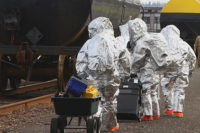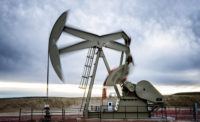Industrial hygiene practices are often overlooked on oil and gas fields

A 57-year-old trucker with five children was found by fellow oil workers slumped over dead next to a tank hatch at an oil well near Ardmore, Okla., on March 20, 2014. It was his second day back hauling for an oil and gas industry transportation contractor, which owned the trailer hooked to the back of his truck. He had been assigned to haul a load of crude oil. The driver parked his truck and climbed a catwalk to the top of the tanks. Before they fill up their tankers, truckers need to measure and sample the tanks. To do this, they pop the “thief hatch” atop the tank, potentially exposing themselves to toxic gases. Then, they dip in their instruments for measurements.
The victim wore a meter to detect hydrogen sulfide, or “sour gas,” which smells like rotten eggs. Hydrogen sulfide is a well-known killer in the oil fields. But the meter was not designed to detect hydrocarbons.
The OSHA inspector who investigated this death found that the industry’s method for avoiding toxic exposure to hydrocarbons amounted to little more than telling workers to stand upwind.
“This is considered an acceptable industry standard,” the inspector wrote in his report. He used capital letters to emphasize: “UNACCEPTABLE.”
Beyond hydrogen sulfide
Industrial hygiene practices in many oil patches are unacceptable, according to IH experts. “The most serious risk is the recognition that there are other exposure hazards beyond hydrogen sulfide. The O&G industry focuses heavily on hydrogen sulfide to a point that workers are often ill-informed of other exposure hazards, signs, symptoms, and exposure control measures. The belief that “if there is no hydrogen sulfide, there is no problem” is rampant in the upstream businesses, said Bart Dawson, member of the American Industrial Hygiene Association’s Oil and Gas Working Group.
Said another IH expert: “The most significant risk in oil and gas extraction is exposure to mixed hydrocarbon vapor when manually gauging or sampling production tanks containing crude oil having a significant volume of light hydrocarbons—butanes, pentanes, hexanes and single ring aromatics—that remain in the liquid phase at elevated storage pressures. These tasks are normally conducted by field production or transportation personnel. Nearly all of them have the same acute toxic effect –central nervous system depression, up to and including cardiac arrhythmia.”
Are adequate numbers of industrial hygienists anticipating, detecting, evaluating, and controlling dangerous exposures in oil boom country? “Not in my opinion,” said this industry IH expert.
Feeble strategies
He explained: “It seems that many production companies and safety personnel believe that a four-gas monitor (having a combustible gas sensor) is an adequate means of identifying exposure risk to vapors during these tasks. Essentially, individuals use the alarm at 10 percent LEL on these units as an indicator of risk and are directed to “move away” or “reposition upwind” in a manner that reduces the concentration at the detector to below the alarm level.
“In reality, it is nearly impossible to conduct these tasks without the unit alarming. Using vapor combustibility as an indicator of toxicity is, at least, inaccurate. Further, mitigating the risk using administrative control strategies as feeble as body position indicates a significant gap in control of this hazard. This risk should be adequately characterized by individuals who are industrial hygienists or are, at least, more familiar with IH strategies. To my current knowledge, this is not occurring across the industry—only in certain organizations (typically larger) that have dedicated IH staff. There are many organizations that do not have IH staff,” the IH expert continued
Death from overexposure
That’s a tragedy. The death of the trucker in March 2014, is one of at least nine fatalities that officials at NIOSH have linked to toxic vapors at oil production sites. The first death was in 2010 in Montana, and the list includes deaths in Colorado, North Dakota, and Texas. All nine men were found dead over hatches or near crude oil tanks they were measuring by hand as part of their job.
Traffic crashes are by far the biggest killers on oil patches, but workers do face numerous health risk exposures. As mentioned earlier, chief among these is hydrogen sulfide. H2S is often found in oil and natural gas deposits, and in some mineral rock. With high levels of H2S, poisoning can be swift and deadly—with little warning. A worker who is not wearing protective equipment may pass out quickly. The body may tremble, and death may follow within seconds or minutes as a result of breathing failure. It may be possible to revive the victim, but only if first aid is given right away.
Drilling fluids is another high-risk exposure. Workers who spend a significant portion of their shifts in the following areas may be overexposed to hydrocarbons and oil mist: drilling floor, chemical mixing station/room, mud pits/tanks—where treated drilling fluids are retained prior to pumping to the drill hole—and shale shakers, where drill cuttings are “shaken” from the drilling fluids that return from the drill hole.
Silica concerns
Silica is a another widespread exposure concern in the oil and gas industry. In 2010, NIOSH partnered with natural gas companies to measure worker exposure to respirable crystalline silica. One hundred sixteen samples were collected at 11 sites throughout the United States; 47 percent showed silica exposures greater than the calculated OSHA PEL and 79 percent had levels greater than the ,pre stringent NIOSH REL; 9 percent were 10 or more times the OSHA PEL; and 31 percent were 10 or more times over the NIOSH REL.
NIOSH researchers identified seven primary sources of silica dust exposure during hydraulic fracturing operations: 1) ejected from thief hatches on the top of sand movers; 2) ejected from side fill ports on the sides of sand movers; 3) generated by onsite vehicle traffic; 4) released from transfer belt under sand movers; 5) created when sand is moved into or agitated in a blender hopper; 6) released from transfer belts between sand mover and blender; and 7) released from top of a sand transfer belt. Several job tasks were identified as having silica exposures exceeding OSHA and NIOSH exposure limits, in particular those working near sand operations. To date, there have not been reports of silica-related disease in the oil and gas workforce.
Other IH exposures in oil and gas extraction include diesel fuel, naturally occurring radioactive materials in the earth’s crust, confined spaces (storage tanks, vessels, boilers, ductwork, tunnels, pits and pipelines), and high noise levels from drilling, pumps, turbine-power generators, and other machinery.
OSHA health standard violations
From October 2010 to September 2011, OSHA conducted 141 inspections of oil and gas drilling sites and 122 inspections of oil and gas field services. The top health-related violations included work in confined spaces (1910.146); violations in hazard communication (1910.1200); medical services & first aid (1910.151); respiratory protection (1910.134); and injury/illness recordkeeping (1904.7). NIOSH researchers believe that underreporting of injuries is common in the oil and gas industry.
The price of overexposures and OSHA violations is difficult to quantify. It’s problematic to track the extent of occupational illness in any industry. Occupational illness is often unrecognized as work-related or not reported to OSHA or the employer, and is rarely claimed in the workers’ compensation system. A national medical surveillance system for occupational illness fatalities comparable to the Census of Fatal Occupational Injuries (CFOI) does not exist.
Recommendations for protecting workers
Based on workplace observations at the sites visited, NIOSH researchers identified a number of general recommendations to reduce the potential for occupational exposures in oil and gas work:
1. Develop alternative tank gauging procedures so workers do not have to routinely open hatches on the tops of the tanks and manually gauge the level of liquid.
2. Develop dedicated sampling ports, other than the thief hatches, that minimize workers’ exposures to volatile organic compound emissions while manually tank gauging.
3. Provide worker training to ensure that flowback technicians understand the hazards of exposure to benzene and other hydrocarbons, and the importance of monitoring atmospheric conditions for LEL concentrations.
4. Limit the time spent in proximity to hydrocarbon sources.
5. Monitor workers to determine their exposure to benzene and other contaminants.
6. Establish a controlled perimeter (similar to the high-pressure zone established during hydraulic fracturing) around flowback tanks. Limit entry and require that any portable tents or sunshades remain outside and upwind of the controlled area.
7. Provide workers with calibrated portable flammable gas monitors with alarms at appropriate levels. The actions to be taken if the alarm sounds should be defined before the detector system is put into use.
8. Use appropriate respiratory protection in areas where potentially high concentrations of hydrocarbons can occur as an interim measure until engineering controls are implemented. OSHA regulations (29 CFR 1910.134) require a comprehensive respiratory protection program be established when respirators are used in the workplace.
9. Use appropriate impermeable gloves to protect against dermal exposures during work around flowback and production tanks and when transferring process fluids.
Looking for a reprint of this article?
From high-res PDFs to custom plaques, order your copy today!






